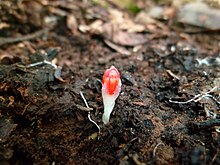
Summary
Thismiaceae is a family of flowering plants whose status is currently uncertain. The Angiosperm Phylogeny Group classifications (APG II, APG III , and APG IV) merge Thismiaceae into Burmanniaceae, noting that some studies have suggested that Thismiaceae, Burmanniaceae and Taccaceae should be separate families, whereas others support their merger.[1]

The family has been recognized by some authors (like J. Hutchinson, Chase et al. 1995,[2] 2000;[3] Caddick et al. 2000;[4][5] Neyland 2002;[6] Thiele & Jordan 2002,[7] Merckx et al. 2006[8] and Woodward et al. 2007[9]). Others have supported the APG position of merging the family into Burmanniaceae, sometimes as the tribe Thismieae (Maas-van de Kamer in Kubitzki system[10] and others).
For those who keep the family separate, it consists of five genera, three (Afrothismia, Haplothismia and Oxygyne) are entirely from Old World, Thismia is from tropical areas of both America and Asia, as well as three temperate species in Illinois (U.S.A), Japan and New Zealand, temperate Australia and Tiputinia is from the Amazon basin.
- List of genera
- Afrothismia (Engl.) Schltr.
- Haplothismia Airy Shaw
- Oxygyne Schltr.
- Relictithismia Suetsugu, Yas.Nakam. & Tagane
- Thismia Griff.
- Tiputinia P.E. Berry & C. L. Woodw.
References edit
- ^ Angiosperm Phylogeny Group (2016). "An update of the Angiosperm Phylogeny Group classification for the orders and families of flowering plants: APG IV". Botanical Journal of the Linnean Society. 181 (1): 1–20. doi:10.1111/boj.12385.
- ^ Chase, M.W., Stevenson, D.W., Wilkin, P. & Rudall, P.J. 1995. Monocot systematics: a combined analysis. Pp. 685–730 in: Rudall. P.J., Cribb, P.J., Cutler, D.F. & Humphries, C.J. (eds.), Monocotyledons: Systematics and Evolution.Royal Botanic Garden, Kew.
- ^ Chase, M.W., Soltis, D.E., Soltis, P.S., Rudall, P.J., Fay, M.F., Hahn, W.H., Sullivan, S., Joseph, J., Molvray, M., Kores, P.J., Givnish, T.J., Sytsma, K.J. & Pires, J.C. 2000. Higher-level systematics of the monocotyledons:an assessment of current knowledge and a new classification.Pp. 3–16 in: Wilson, K.L. & Morrison, D.A.(eds.), Monocots: Systematics and Evolution. CSIRO Publishing, Collingwood.
- ^ Caddick, L.R., Rudall & P. Wilkin, P.J. 2000. Floral morphology and development in Dioscoreales. Feddes Repert. 111: 189–230.
- ^ Caddick, L.R., Rudall, P.J., Wilkin, P. & Chase, M.W. 2000. Yams and their allies: systematics of Dioscoreales. Pp. 475–487 in: Wilson, K.L. & Morrison, D.A. (eds.), Monocots: Systematics and Evolution. CSIRO Publishing, Collingwood.
- ^ Neyland, R. 2002. A phylogeny inferred from large-subunit (26S) ribosomal DNA sequences suggests that Burmanniales are polyphyletic. Austral. Syst. Bot. 15: 19–28.
- ^ Thiele, K.R. & Jordan, P. 2002. Thismia clavarioides (Thismiaceae),a new species of fairy lantern from New South Wales. Telopea 9: 765–771.
- ^ Merckx, V., Schols, V., Maas-van de Kamer, H., Maas, P., Huysmans, S., & Smets, E. (2006). Phylogeny and evolution of Burmanniaceae (Dioscoreales) based on nuclear and mitochondrial data. American Journal of Botany 93: 1684-1698
- ^ Woodward, C. L.; Berry, P. E.; Maas-van de Kamer, H.; Swing, K. (2007). Tiputinia foetida, a new mycoheterotrophic genus of Thismiaceae from Amazonian Ecuador, and a likely case of deceit pollination. Taxon 56(1):157-162.
- ^ Maas-van de Kamer, H. (1998). Burmanniaceae. Pp.154–163 in: Kubitzki, K., Huber, H., Rudall, P.J., Stevens, P.S. & Stützel, T. (eds), The Families and Genera of Vascular Plants, Vol. III, Monocotyledons: Lilianae (except Orchidaceae). Springer-Verlag, Berlin.
External links edit
Media related to Thismiaceae at Wikimedia Commons
- Thismiaceae in L. Watson and M.J. Dallwitz (1992 onwards). The families of flowering plants: descriptions, illustrations, identification, information retrieval.
- Thismiaceae in Neotropikey, key and other information resources for flowering plants of the Neotropics from Kew


